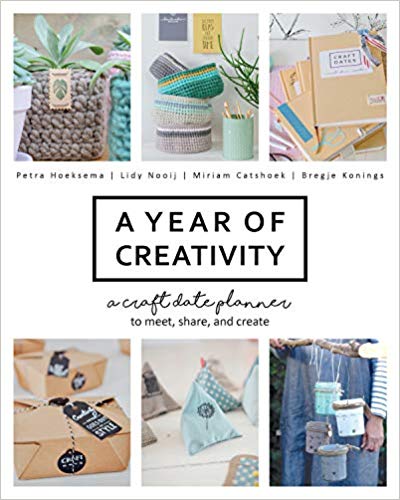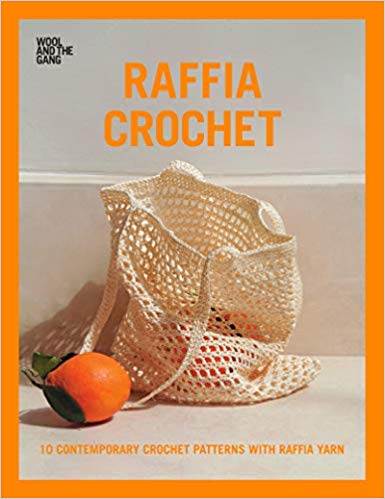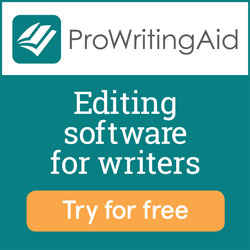Reading Fanatic Reviews
Hobbies & PastimesA Year of Creativity by Petra Koeksema et al.

A Year of Productivity*
Craft Date Ideas
The subtitle of this book states that it is a “craft date planner.” I believe the authors misspoke. When I think of a planner, I think of something that I can write in as I strategize something, whether it’s my day or a project. This is really more of a book that introduces the concept of a craft date if you aren’t familiar with it and gives some ideas for projects for the group.
The idea of a craft date is to get together with like-minded friends and craft together. Sometimes, the group might work on a single project together, like a gift for a mutual friend. Other times, the group might work individually, each participant making the same project but fashioned for her own likes and dislikes. Another possibility would be to work on a variety of small projects during the craft date time. As you can see, it really depends on what the group wants to do in general and on a particular day.
The bulk of the book is pictures of and directions for a variety of projects that a craft date group could do. In the table of contents, these are color coded to show whether they are short, longer, or cooperative projects. In flipping through the book, none of them looked particularly difficult, which I imagine would be a criterion for a craft date project. The crafts in this book include crochet, knitting, sewing, and even a little straight-up crafting, like making a wooden coat rack or a tool station. Each project has packaging instructions—some very creative—if you are planning to give the item as a gift.
When looking at the projects themselves, some were wholly contained within the main portion of the book, while others had directions (partial or complete) in the back of the book. I know this is a long-standing tradition in craft books, but I’m not a particular fan of it, and I don’t think it was well done in this book. It made for a very picture-heavy central portion and a very text-heavy end section. There was one project where all it showed were pictures in the main part—four pages worth—and had the directions only in the back. I would have loved to have seen all the directions integrated into the main part with the photographs scattered throughout the project’s section. It just breaks up the tedium of the pages and helps you to see what a project should look like, from a variety of angles, when the directions and the picture are on the same page.
I am a knitter and crocheter, but I do not sew nor do I do the other types of crafts that are in this book. In looking at the directions for the knitting and crochet projects, I found them to be straightforward and easy to read. I also like the diagrams for crochet. I thought that the way the patterns were written was a little odd. Having crafted since I was a teenager, I am very familiar with pattern shorthand (i.e., dc for double crochet or K5 to mean “knit 5 stitches”). This book didn’t use that, and it actually felt strange to see all those words written out. Perhaps if the authors had used the standard shorthand, they could have included the full directions in the main part of the book like I mentioned before.
The book definitely has some projects that look like they are worth doing, either alone or in a group. As someone who has crafted off and on throughout her life, this is just the sort of book to fire up my imagination and make me want to break out my favorite crafting tools and have a go. They would be more fun to do with others, that’s for sure, especially if the group is made up of truly like-minded individuals.
Read This if You Want to Take Good Photographs by Henry Carroll
eBook available at Amazon only
Read This if You Want to Take Good Photographs*
The Philosophy of Photography
As the author states in the introduction of the book, this is not a work that focuses on the technical aspects of photography. Yes, there are sections on exposure, white balance, and lenses, but the book is more about fostering the development of an artistic eye. To aid in that, the author has a selection of photographs that he uses as an example to discuss topics like framing, symmetry, different types of light, and the dangers of perfection. The book is actually a set of mini essays about these topics and others. I would almost call it philosophical in nature, as it does get you to think about your perception of the world and what you can capture with a camera. I love how the book starts, where he just shows a box with a hole in it, saying that this is your camera. I think he wants to take away any fear of the complexity of modern cameras and show as well that the focus of this book is really on the photographer, not the camera. If you are into photography at all, you will most likely find this book and its collection of essays and striking photographs an interesting read and much food for thought.
Buying and Selling Old Stuff by Dixie Maria Carlton
Available at Amazon only
Free with Kindle Unlimited
Buying and Selling Old Stuff*
Short Read, But Good Info
This is a super short book, but the author clearly has a wide range of experience in this topic because she has jam-packed it full of information. She especially seems to have extensive knowledge of estate jewelry. The book, as the title suggests, works whether you have some of your own antiques to sell–as she gives you clear directions on how to place a value on them and how to approach selling–or whether you wish to get into buying antiques. I did find myself wishing that there was a little more information on occasion, but this is a great start if you’re interested in getting into either part of antiquing.
What Is Wrong with Twitter by Kurt Seapoint
Available at Amazon, Barnes & Noble, iBooks, Kobo, Thalia, and Bol.de
What is Wrong with Twitter*
If You’re Really into Twitter, Read this Book
I will admit that I find myself surprised at all this book contains. I have been a member of Twitter for a couple of years, but I’ve only used it sporadically. This book reveals a world of tweetdom that I had no idea existed. If you want to use the platform to your best advantage, you might find this book, which details both recent changes in Twitter and how to best leverage the platform while staying compliant and community friendly, a helpful and engrossing read.
Chess Opening Names by Nathan Rose
Available at Amazon only
Free with Kindle Unlimited
Chess Opening Names*
A Look into the Origins of Chess Openings
This is a surprisingly interesting book about the origins of the names of chess opening strategies. The book is divided into three main sections, depending on the origin of the opening: people, places, and stories. For the people section, he gives a little background about the person for whom an opening is named, sometimes putting the man and the moves into historical context as well. If there is a written source for the opening, that is included as well.
There is only one downside to this book. The author has chosen to use algebraic chess notation but doesn’t explain what that is and how to interpret it. Rather, he refers you to a video about it on his website. In a book where so much depends upon each individual move in the opening, I think that an explanation of this system is required for both chest novices and more experienced players who don’t know about this notation. As a visual person, too, I might have liked to have seen the chess diagram boards with arrows and/or numbers showing the move. I will admit to being a chess novice, having only played on occasion, but I do find it an interesting mental challenge. If you have an interest in chess, or even the history of the game, you might find this as engaging a read as I did.
Digital Hand Lettering and Modern Calligraphy by Shelly Kim
Available at Amazon, Barnes & Noble, iBooks, Kobo, Google Play, Thalia, Mondadori, Angus & Robertson, Indigo (Chapters), and Bol.de
Digital Hand Lettering and Modern Calligraphy*
Amazing Book on Hand Lettering in the Modern Age
What a visually stunning book! I have done the standard style of calligraphy since I was a teenager (and I am more than double that age now!), so I have an appreciation for hand lettering and calligraphy. The book is not only beautiful to look at, but it is the perfect primer for someone who really wants to get into this. The book is structured into four sections. The first talks about the basics, including tools and strokes. The second section is about taking your hand lettering digital, and the third specifically talks about working with hand lettering on the iPad. Finally, the book ends with a series of projects. It is lavishly Illustrated with full-color photos of the tools, the hand lettering/calligraphy, and the steps to the projects. If you have any interest in this topic, I highly recommend you pick it up. I would certainly recommend the paperback version; it and the eBook are close in price anyway, so you might as well get the full appreciation of what it all looks like in a physical book. If you read and follow along, it will set you up to be a good hand letterer—both by hand and in print.
Raffia Crochet by Wool and The Gang

Only available in paperback
Amazon, Barnes & Noble
Raffia Crochet*
Ten Basic Crochet Projects Using Raffia
In this book, designers for Wool and the Gang have gathered ten patterns that use their yarn Ra-ra-raffia. Most of the designs are for accessories and things for around the house, like a placemat, backpack, or shopping bag. The first pattern is for a hat that actually does look like it would be perfect for summer. I’ve been a crocheter and a knitter for a long time, but I had never heard of raffia being used like yarn to make projects. Other than the plant hanger, I actually liked the projects in this book; they seem very functional (although I wish the placemat was rectangular and not round). I could see how for specific items, especially the bags, raffia could be a good material from which to make them. The patterns are mostly simple and straightforward. For a few of them, there are instructions given how to jazz them up a little with some applique. If you’ve done much crocheting, there’s little here that’s beyond your reach. There is a section in the back that does give some description of technique, like how to do a magic loop. The book is limited with only ten projects. I also felt that there was some inconsistency in how the patterns were written. But if you are interested in some basic raffia crochet projects, you might enjoy this book.
Step-By-Step Guide to 200 Crochet Stitches by Tracey Todhunter
Available in paperback only
Available at Amazon, Barnes & Noble, Interweave, Target
Step-by-Step Guide to 200 Crochet Stitches*
Beautiful, Clear Collection of Stitches
If you enjoy crocheting, this book would be a good one to add to your crafting books. It is chock full of 200 basic and not-so-basic crochet stitches, including some intriguing ones like Embossed Shells, Four-Leaf Clover, Popcorn Mesh, Granny Spike Stitch, Post Stitch Stripes, Little Arcs, Textured Wave, Tunisian Honeycomb, and Crown Picot Edging.
I’ve been crocheting for over 30 years, and I saw some old friends and some new ones that make me want to dig out my hooks and yarn and start playing around with these stitches! I can think of no better recommendation of a book than that.
You definitely need to have a good sense of basic crochet, like how to do a chain, single crochet, double crochets, post stitches, etc. The Basic Stitches section at the front of the book does not contain these simplest of stitches; rather those stitches are more along the lines of slightly altered basic stitches like the Purl Slip Stitch and Shallow Single Crochet. There is a section called Crochet Skills in the back which does show some crochet basics, but many of the stitches in the main part of the book are complex enough that you’d want to have some solid experience under your belt before you attempt them. You don’t need a lot of experience, just enough to feel comfortable working with crochet projects.
The stitch sections in the main part of the book include Basic Stitches; Fans & Shells; Clusters, Puffs, & Popcorns; Spike Stitches; Raised Stitches; Mesh and Filet; Lace & Openwork; Waves & Chevrons; Textured Stitches, Tunisian Stitches; Colorwork; and Edgings. Each stitch has a full-color photo of multiple rows as well as up-close pictures of the yarn and hook every one or two steps. There is also a stitch diagram if you prefer working with those. If you are a visual learner, it’s nice to see exactly what you’re supposed to do or what the result is.
My only complaint is that some of the yarn and hook combinations don’t show enough contrast between the yarn and hook colors. For instance, there’s a whole set of stitches that use a golden yarn with what looks like a light wooden hook. These two colors blend together too easily and you don’t see the contrast.
Again, if you love to crochet, I would suggest picking this book up, digging out your hooks, busting into your stash, and start having fun!






